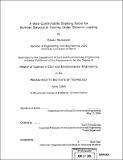| dc.contributor.advisor | Kevin Amaratunga. | en_US |
| dc.contributor.author | Manasseh, Mazen, 1980- | en_US |
| dc.contributor.other | Massachusetts Institute of Technology. Dept. of Civil and Environmental Engineering. | en_US |
| dc.date.accessioned | 2005-10-14T20:13:46Z | |
| dc.date.available | 2005-10-14T20:13:46Z | |
| dc.date.issued | 2004 | en_US |
| dc.identifier.uri | http://hdl.handle.net/1721.1/29382 | |
| dc.description | Thesis (S.M.)--Massachusetts Institute of Technology, Dept. of Civil and Environmental Engineering, 2004. | en_US |
| dc.description | "June 2004." | en_US |
| dc.description | Includes bibliographical references (leaf 73). | en_US |
| dc.description.abstract | The thesis presents a remotely accessible system for controlling a shaker table laboratory experiment. The Shake Table WebLab is implemented at MIT's Civil Engineering Department under the Microsoft-sponsored iLab initiative for the development of educationally-oriented virtual experiments. Facilitated accessibility, safe operation and expandability are essentials at the root of the design and implementation of the Shake Table WebLab. The fully functional system allows students and researchers to excite a two-story structure, which is three feet high, by vibrating its base while receiving accelerometer readings from its three levels. Registered Internet users may upload their own input data, such as the seismic ground acceleration of a newly occurring earthquake, and therefore study the corresponding behavior of a real structure. The system is designed with an expandable architecture which enables future researchers to add functionalities that suit their fields of interest. Relevant fields of study include real-time signal processing and filtering techniques that would provide an understanding of how earthquakes affect a structure and therefore provide insight on means to minimize encountered damage in large-scale structures. An already developed tool utilizes frequency domain transfer functions to compare the measured structural response at the upper levels with a predictable result based on seismic vibrations applied at the structure's base. Two main characteristics of the web-based application are interactivity, provided through synchronized control/response processes, and sensor-based monitoring of the experiment. | en_US |
| dc.description.abstract | (cont.) The system is built on the Microsoft .Net Framework through server-hosted Active Server Pages and browser-embedded Windows Form Controls. Web Service methods are implemented for initiating remote processes. Throughout the thesis, I state the motivations for conducting this project, the different online activities and generic administrative features, and a description of the implemented technologies and system components. | en_US |
| dc.description.statementofresponsibility | by Mazen Manasseh. | en_US |
| dc.format.extent | 79 leaves | en_US |
| dc.format.extent | 3221753 bytes | |
| dc.format.extent | 3221561 bytes | |
| dc.format.mimetype | application/pdf | |
| dc.format.mimetype | application/pdf | |
| dc.language.iso | eng | en_US |
| dc.publisher | Massachusetts Institute of Technology | en_US |
| dc.rights | M.I.T. theses are protected by copyright. They may be viewed from this source for any purpose, but reproduction or distribution in any format is prohibited without written permission. See provided URL for inquiries about permission. | en_US |
| dc.rights.uri | http://dspace.mit.edu/handle/1721.1/7582 | |
| dc.subject | Civil and Environmental Engineering. | en_US |
| dc.title | A web-controllable shaking table for remote structural testing under seismic loading | en_US |
| dc.type | Thesis | en_US |
| dc.description.degree | S.M. | en_US |
| dc.contributor.department | Massachusetts Institute of Technology. Department of Civil and Environmental Engineering | |
| dc.identifier.oclc | 56124920 | en_US |
